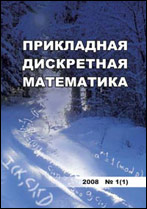|
This article is cited in 2 scientific papers (total in 2 papers)
Mathematical Backgrounds of Informatics and Programming
Minimization of context-free grammars
Yu. D. Ryazanov, S. V. Nazina
Belgorod State Technological University named after V. G. Shukhov, Belgorod, Russia
Abstract:
This paper solves the problem of transforming the initial context-free grammar (CF-grammar) without excess characters into equivalent CF-grammar with less complexity. To solve this problem, the following relation on the set of a CF-grammar non-terminals is introduced: $E = \{(X,Y): (X=Y) \vee (X\to \alpha\Leftrightarrow Y\to \beta \wedge\vert \alpha \vert = \vert \beta \vert \wedge \forall i\,(\alpha (i) = \beta (i)\vee (\alpha (i), \beta (i))\in E))\}$
where $X$, $Y$ are non-terminals, $\alpha$, $\beta$ are chains of terminal and non-terminals, possibly blank, $\alpha (i)$ is the $i$-th character in chain $\alpha$, $\beta (i)$ is the $i$-th character in chain $\beta$. It is proved that the relation $E$ has the equivalence property and splits the set of non-terminals into equivalence classes. An algorithm is proposed for splitting a set of non-terminals into equivalence classes based on the method of sequential decomposition of the set of non-terminals into subsets so that non-equivalent non-terminals fall into different subsets. New CF-grammar is built on a set of non-terminals $N$, which elements are representatives of equivalence classes. From the set of rules of the initial CF-grammar, the rules with the left parts belonging to the set $N$ are chosen. If there is a non-terminal in the left side of any selected rule that does not belong to the set $N$, then it is replaced by its equivalent non-terminal from the set $N$. After such transformations in the CF-grammar, sets of identical rules may appear. From each set of identical rules, we leave only one rule. The result is a CF-grammar containing less rules and non-terminals than the initial CF-grammar. The paper provides an example of the implementation of the described transformations.
Keywords:
formal language, formal grammar, equivalence relation, minimization.
Citation:
Yu. D. Ryazanov, S. V. Nazina, “Minimization of context-free grammars”, Prikl. Diskr. Mat., 2019, no. 45, 90–96
Linking options:
https://www.mathnet.ru/eng/pdm675 https://www.mathnet.ru/eng/pdm/y2019/i3/p90
|

| Statistics & downloads: |
| Abstract page: | 159 | | Full-text PDF : | 104 | | References: | 31 |
|




 Contact us:
Contact us: Terms of Use
Terms of Use
 Registration to the website
Registration to the website Logotypes
Logotypes








 Citation in format
Citation in format 
